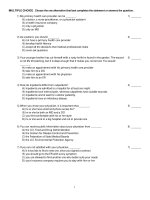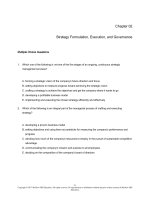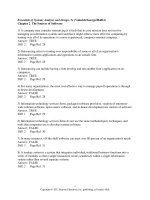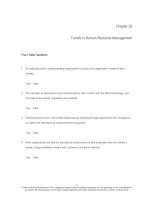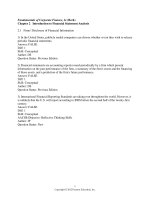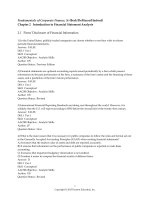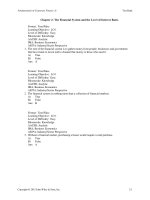Fundamentals of taxation 2012 5th edition cruz test bank
Bạn đang xem bản rút gọn của tài liệu. Xem và tải ngay bản đầy đủ của tài liệu tại đây (102.98 KB, 34 trang )
Chapter 01 - Introduction to Taxation, the Income Tax Formula, and Form 1040EZ
Chapter 01
Introduction to Taxation, the Income Tax Formula, and Form 1040EZ
True / False Questions
1. The U.S. individual income tax system is an example of a progressive tax rate structure.
True False
2. A proportional tax rate structure is a tax where the tax rate remains at the same rate
regardless of the tax base.
True False
3. Under a flat tax, the marginal tax rate and the average tax rate are different.
True False
4. State and local taxes levied on either property or sales are examples of progressive taxes.
True False
5. With a regressive tax, the tax rate decreases as the tax base gets larger.
True False
6. The marginal tax rate is the total tax liability divided by the taxable income.
True False
7. The average tax rate is the total tax liability divided by the taxable income.
True False
1-1
Chapter 01 - Introduction to Taxation, the Income Tax Formula, and Form 1040EZ
8. All individual income tax returns follow the structure of the simplified tax formula.
True False
9. The average tax rate is always smaller than the marginal tax rate.
True False
10. At high levels of taxable income, the average tax rate and the marginal tax rate will be the
same.
True False
11. Wages, salaries, and tips are compensation for services rendered. However, commissions,
bonuses, and severance pay are not taxable.
True False
12. Federal unemployment compensation benefits are not taxable.
True False
13. A single taxpayer cannot file a Form 1040EZ if she is age 65 or older.
True False
14. One of the criteria to file a Form 1040EZ is that the total taxable income of the taxpayer
cannot exceed $100,000.
True False
15. Employers report wage income to employees on a Form W-3.
True False
1-2
Chapter 01 - Introduction to Taxation, the Income Tax Formula, and Form 1040EZ
16. Individuals who file a Form 1040EZ will determine their tax liability with reference to a
tax rate schedule.
True False
17. Taxpayers normally pay their tax liability when they file their income tax return.
True False
18. The amount of tax liability is affected by the filing status of the taxpayer.
True False
19. The tax liability of a single individual with taxable income of $31,689 is $4,334.
True False
20. Tax liability is calculated using income before permitted deductions. Permitted deductions
are then subtracted from the tax liability.
True False
21. There are two types of primary tax authority: statutory and judicial.
True False
22. Typically, federal tax legislation is introduced in the Senate Finance Committee.
True False
23. IRS Regulations are by far the strongest administrative authority.
True False
1-3
Chapter 01 - Introduction to Taxation, the Income Tax Formula, and Form 1040EZ
24. A Private Letter Ruling is tax authority only to the taxpayer to whom it is issued.
True False
25. One major disadvantage the taxpayer has when filing a petition with the Tax Court is that
the IRS's proposed tax assessment must be paid prior to trial.
True False
Multiple Choice Questions
26. A tax rate that increases as the tax base increases is an example of what kind of tax rate
structure?
A. Progressive.
B. Proportional.
C. Regressive.
D. Recessive.
27. A tax rate that remains the same as the tax base increases is an example of what kind of
tax rate structure?
A. Progressive.
B. Proportional.
C. Regressive.
D. Recessive.
28. A tax rate that increases as the tax base decreases is an example of what kind of tax rate
structure?
A. Progressive.
B. Proportional.
C. Regressive.
D. Recessive.
1-4
Chapter 01 - Introduction to Taxation, the Income Tax Formula, and Form 1040EZ
29. A tax rate structure where the tax rate remains at the same rate regardless of the tax base
is:
A. A progressive rate structure.
B. A proportional rate structure.
C. A regressive rate structure.
D. None of the above.
30. Which of the following is an example of a regressive tax?
A. Federal income tax.
B. State and local taxes levied on property.
C. Sales tax.
D. Social security tax.
31. The federal income tax is an example of a:
A. Progressive rate structure.
B. Proportional rate structure.
C. Regressive rate structure.
D. Flat tax structure.
32. Jake earned $15,000 and paid $1,500 of income tax, while Jill earned $40,000 and paid
$3,000 of income tax. The structure of the tax their income is subject to is:
A. Progressive.
B. Proportional.
C. Regressive.
D. Flat.
1-5
Chapter 01 - Introduction to Taxation, the Income Tax Formula, and Form 1040EZ
33. Jordan and Paul, a married couple, have taxable income of $48,025 which is taxed as
follows:
Their marginal tax rate is:
A. 0%.
B. 10%.
C. 13.3%.
D. 15%.
34. Jordan and Paul, a married couple, have taxable income of $48,025 which is taxed as
follows:
Their average tax rate is:
A. 0%.
B. 10%.
C. 13.3%.
D. 15%.
35. Which statement is correct with respect to marginal and average tax rates under a
progressive tax structure?
A. At very high levels of taxable income, a taxpayer's marginal and average tax rates will be
the same.
B. At very low levels of taxable income, a taxpayer's marginal and average tax rates will be
the same.
C. For most taxpayers, the average tax rate is larger than the marginal tax rate.
D. Generalizations cannot be made. The question can only be answered with reference to the
tax situation of a specific taxpayer.
1-6
Chapter 01 - Introduction to Taxation, the Income Tax Formula, and Form 1040EZ
36. With respect to the income tax formula, which of the following statements is correct?
A. The simplified income tax formula is only applicable to taxpayers with taxable income less
than $100,000.
B. Tax liability is determined by applying an appropriate tax rate to total income.
C. Certain deductions from income are permitted before calculating tax liability.
D. Tax payments are ignored when calculating the tax refund or tax due with the return.
37. Which of the following statements is true with respect to marginal and average tax rates
under a progressive tax structure?
A. Marginal rates are always larger than average rates.
B. Marginal rates are always smaller than average rates.
C. Average rates can only be calculated for taxpayers with income over $100,000.
D. Average rates are never more than marginal rates.
38. Which of the following would disqualify a taxpayer from filing a Form 1040EZ?
A. The taxpayer is married.
B. The taxpayer has interest income of $1,400.
C. The taxpayer is age 66.
D. The taxpayer received unemployment compensation income of $1,700.
39. Which of the following would disqualify a taxpayer from filing a Form 1040EZ?
A. The taxpayer has total income of $74,000.
B. The taxpayer has interest income of $500.
C. The taxpayer is age 63.
D. The taxpayer has one dependent.
40. Which of the following would disqualify a taxpayer from filing a Form 1040EZ?
A. Has total taxable income under $100,000.
B. Be age 68 and not blind.
C. Has no dependents.
D. Has interest income less than $1,500.
1-7
Chapter 01 - Introduction to Taxation, the Income Tax Formula, and Form 1040EZ
41. Employers report wage income to employees on a:
A. Form W-2.
B. Form W-3.
C. Form 1099-E.
D. Form 1099-G.
42. Interest payers (banks, savings and loans, insurance companies, etc.) report interest
earnings to taxpayers on a:
A. Form W-2-INT.
B. Form 1099-INT.
C. Form 1099-INC.
D. Form 4070.
43. On Form 1040EZ, the permitted deduction from income for a single taxpayer is:
A. $0.
B. $9,350.
C. $10,000.
D. $18,700.
44. In terms of dollars, wage earning taxpayers will normally pay the majority of their tax
liability:
A. When they file their tax return.
B. Through withholding from their wages.
C. In the following tax year.
D. In advance in January.
45. Victoria determined her tax liability was $6,145. Her employer withheld $6,451 from her
paychecks during the year. Victoria's tax return would show:
A. A refund of $306.
B. A refund of $6,451.
C. Tax due of $306.
D. Tax due of $6,145.
1-8
Chapter 01 - Introduction to Taxation, the Income Tax Formula, and Form 1040EZ
46. The tax liability for a single individual with taxable income of $67,493 is:
A. $13,061.
B. $13,056.
C. $11,721.
D. $9,286.
47. The tax liability for a married couple with taxable income of $92,409 is:
A. $20,011.
B. $19,599.
C. $17,957.
D. $15,481.
48. For equivalent amounts of taxable income, the total tax liability of a single individual:
A. Will be less than married filing jointly.
B. Will be more than married filing jointly.
C. Will be more than married filing separately.
D. Cannot be determined with the information provided.
49. Hamad is an employee of Mountain Company. He properly completed his Form 1040EZ
tax return and was required to pay the IRS $1,244 at the time of filing. He had income tax
withholding during the year of $4,782. Hamad's tax liability for the year was:
A. $1,244.
B. $3,538.
C. $4,782.
D. $6,026.
50. Alice is an employee of Valley Company. She properly completed her Form 1040EZ tax
return and received a refund from the IRS of $1,244. Alice had income tax withholding during
the year of $4,782. Her tax liability for the year was:
A. $1,244.
B. $3,538.
C. $4,782.
D. $6,026.
1-9
Chapter 01 - Introduction to Taxation, the Income Tax Formula, and Form 1040EZ
51. Peter and Penelope are married and have combined W-2 income of $57,421. They paid an
additional $127 when they filed their taxes. How much income tax did their employers
withhold during the year?
A. $4,847.
B. $5,101.
C. $7,652.
D. $7,906.
52. Which of the following trial courts hear tax cases?
A. U.S. Tax Court.
B. U.S. District Court.
C. U.S. Court of Federal Claims.
D. All of the above.
53. Which court hears most of the litigated tax disputes between the IRS and taxpayers?
A. U.S. Tax Court.
B. U.S. District Court.
C. U.S. Court of Federal Claims.
D. None of the above.
54. Which of the following are primary sources of tax authority?
A. Statutory sources.
B. Administrative sources.
C. Judicial sources.
D. All of the above.
55. Which of the following is a statutory source of tax authority?
A. Internal Revenue Code.
B. IRS Regulation.
C. Revenue Ruling.
D. Tax Court decision.
1-10
Chapter 01 - Introduction to Taxation, the Income Tax Formula, and Form 1040EZ
56. Which of the following is an administrative source of tax law?
A. Revenue Ruling.
B. IRS Regulation.
C. Private Letter Ruling.
D. All of the above.
57. Which of the following types of Regulations is the strongest tax authority?
A. Final.
B. Legislative.
C. Temporary.
D. Proposed.
58. Which of the following refers to an income tax regulation?
A. Reg. §1.162-5.
B. Reg. §20.2032-1.
C. Reg. §25.2503-4.
D. Reg. §31.3301-1.
59. Which of the following is correct with respect to Private Letter Rulings?
A. Issued when a taxpayer wants to know the tax treatment of a specific tax situation.
B. Can be relied upon by all taxpayers in a similar tax situation.
C. Provides tax authority only to the taxpayer to whom it is issued.
D. Both a and c.
60. Which of the following courts has the highest tax validity?
A. Court of Appeals for the Fifth Circuit.
B. U.S. Court of Federal Claims.
C. U.S. District Court.
D. U.S. Tax Court.
Short Answer Questions
1-11
Chapter 01 - Introduction to Taxation, the Income Tax Formula, and Form 1040EZ
61. Which type of tax rate structure is each of the following types of tax: sales, federal
income, social security, flat, Medicare?
62. What is the definition of a proportional tax?
63. What is the definition of a regressive tax?
64. What is the average tax rate and how is it determined?
1-12
Chapter 01 - Introduction to Taxation, the Income Tax Formula, and Form 1040EZ
65. What is the marginal tax rate and how is it determined?
66. A married couple has taxable income of $98,475 and tax liability of:
Determine their marginal tax rate and their average tax rate.
67. There are six criteria a taxpayer must meet in order to file a Form 1040EZ. List them.
68. Your friend works as a salaried employee of a large local corporation. She told you that
she paid $2,592 when she filed her tax return so her tax liability was equal to that amount.
What is the fallacy in her statement?
1-13
Chapter 01 - Introduction to Taxation, the Income Tax Formula, and Form 1040EZ
69. Alex is single and had W-2 income of $32,996 and interest income of $211. What is his
taxable income?
70. Determine the tax liability in each of the following cases.
a. Single individual, taxable income of $56,840.
b. Married couple, taxable income of $98,211.
c. Single individual, wage income of $76,319. No other sources of income.
71. The Tax Tables generally provide a slightly different tax liability when compared to the
Tax Rate Schedules. For each of the following amounts of taxable income, determine whether
the tax calculated using the Tax Tables will be larger, smaller, or the same as the tax
calculated using the Tax Rate Schedules.
a. $76,880
b. $82,225
c. $54,711
d. $99,201
e. $99,198
1-14
Chapter 01 - Introduction to Taxation, the Income Tax Formula, and Form 1040EZ
72. Describe the legislative process for enacting a new tax law.
73. What are Revenue Rulings and Revenue Procedures?
74. What is a Private Letter Ruling (PLR)? What tax authority is provided by a PLR?
75. Describe the various courts that hear tax cases. Include both trial courts and appellate
courts in your discussion.
1-15
Chapter 01 - Introduction to Taxation, the Income Tax Formula, and Form 1040EZ
Chapter 01 Introduction to Taxation, the Income Tax Formula, and Form
1040EZ Answer Key
True / False Questions
1. The U.S. individual income tax system is an example of a progressive tax rate structure.
TRUE
Learning Objective: 1
2. A proportional tax rate structure is a tax where the tax rate remains at the same rate
regardless of the tax base.
TRUE
Learning Objective: 1
3. Under a flat tax, the marginal tax rate and the average tax rate are different.
FALSE
Learning Objective: 1
4. State and local taxes levied on either property or sales are examples of progressive taxes.
FALSE
Learning Objective: 1
5. With a regressive tax, the tax rate decreases as the tax base gets larger.
TRUE
Learning Objective: 1
1-16
Chapter 01 - Introduction to Taxation, the Income Tax Formula, and Form 1040EZ
6. The marginal tax rate is the total tax liability divided by the taxable income.
FALSE
Learning Objective: 2
7. The average tax rate is the total tax liability divided by the taxable income.
TRUE
Learning Objective: 2
8. All individual income tax returns follow the structure of the simplified tax formula.
TRUE
Learning Objective: 2
9. The average tax rate is always smaller than the marginal tax rate.
FALSE
Learning Objective: 2
10. At high levels of taxable income, the average tax rate and the marginal tax rate will be the
same.
FALSE
Learning Objective: 2
11. Wages, salaries, and tips are compensation for services rendered. However, commissions,
bonuses, and severance pay are not taxable.
FALSE
Learning Objective: 3
1-17
Chapter 01 - Introduction to Taxation, the Income Tax Formula, and Form 1040EZ
12. Federal unemployment compensation benefits are not taxable.
FALSE
Learning Objective: 3
13. A single taxpayer cannot file a Form 1040EZ if she is age 65 or older.
TRUE
Learning Objective: 3
14. One of the criteria to file a Form 1040EZ is that the total taxable income of the taxpayer
cannot exceed $100,000.
TRUE
Learning Objective: 3
15. Employers report wage income to employees on a Form W-3.
FALSE
Learning Objective: 3
16. Individuals who file a Form 1040EZ will determine their tax liability with reference to a
tax rate schedule.
FALSE
Learning Objective: 4
17. Taxpayers normally pay their tax liability when they file their income tax return.
FALSE
Learning Objective: 4
1-18
Chapter 01 - Introduction to Taxation, the Income Tax Formula, and Form 1040EZ
18. The amount of tax liability is affected by the filing status of the taxpayer.
TRUE
Learning Objective: 4
19. The tax liability of a single individual with taxable income of $31,689 is $4,334.
TRUE
Learning Objective: 4
20. Tax liability is calculated using income before permitted deductions. Permitted deductions
are then subtracted from the tax liability.
FALSE
Learning Objective: 4
21. There are two types of primary tax authority: statutory and judicial.
FALSE
Learning Objective: 5
22. Typically, federal tax legislation is introduced in the Senate Finance Committee.
FALSE
Learning Objective: 5
23. IRS Regulations are by far the strongest administrative authority.
TRUE
Learning Objective: 5
1-19
Chapter 01 - Introduction to Taxation, the Income Tax Formula, and Form 1040EZ
24. A Private Letter Ruling is tax authority only to the taxpayer to whom it is issued.
TRUE
Learning Objective: 5
25. One major disadvantage the taxpayer has when filing a petition with the Tax Court is that
the IRS's proposed tax assessment must be paid prior to trial.
FALSE
Learning Objective: 5
Multiple Choice Questions
26. A tax rate that increases as the tax base increases is an example of what kind of tax rate
structure?
A. Progressive.
B. Proportional.
C. Regressive.
D. Recessive.
Learning Objective: 1
27. A tax rate that remains the same as the tax base increases is an example of what kind of
tax rate structure?
A. Progressive.
B. Proportional.
C. Regressive.
D. Recessive.
Learning Objective: 1
1-20
Chapter 01 - Introduction to Taxation, the Income Tax Formula, and Form 1040EZ
28. A tax rate that increases as the tax base decreases is an example of what kind of tax rate
structure?
A. Progressive.
B. Proportional.
C. Regressive.
D. Recessive.
Learning Objective: 1
29. A tax rate structure where the tax rate remains at the same rate regardless of the tax base
is:
A. A progressive rate structure.
B. A proportional rate structure.
C. A regressive rate structure.
D. None of the above.
Learning Objective: 1
30. Which of the following is an example of a regressive tax?
A. Federal income tax.
B. State and local taxes levied on property.
C. Sales tax.
D. Social security tax.
Learning Objective: 1
31. The federal income tax is an example of a:
A. Progressive rate structure.
B. Proportional rate structure.
C. Regressive rate structure.
D. Flat tax structure.
Learning Objective: 1
1-21
Chapter 01 - Introduction to Taxation, the Income Tax Formula, and Form 1040EZ
32. Jake earned $15,000 and paid $1,500 of income tax, while Jill earned $40,000 and paid
$3,000 of income tax. The structure of the tax their income is subject to is:
A. Progressive.
B. Proportional.
C. Regressive.
D. Flat.
Learning Objective: 1
33. Jordan and Paul, a married couple, have taxable income of $48,025 which is taxed as
follows:
Their marginal tax rate is:
A. 0%.
B. 10%.
C. 13.3%.
D. 15%.
Learning Objective: 2
34. Jordan and Paul, a married couple, have taxable income of $48,025 which is taxed as
follows:
Their average tax rate is:
A. 0%.
B. 10%.
C. 13.3%.
D. 15%.
Learning Objective: 2
1-22
Chapter 01 - Introduction to Taxation, the Income Tax Formula, and Form 1040EZ
35. Which statement is correct with respect to marginal and average tax rates under a
progressive tax structure?
A. At very high levels of taxable income, a taxpayer's marginal and average tax rates will be
the same.
B. At very low levels of taxable income, a taxpayer's marginal and average tax rates will be
the same.
C. For most taxpayers, the average tax rate is larger than the marginal tax rate.
D. Generalizations cannot be made. The question can only be answered with reference to the
tax situation of a specific taxpayer.
Learning Objective: 2
36. With respect to the income tax formula, which of the following statements is correct?
A. The simplified income tax formula is only applicable to taxpayers with taxable income less
than $100,000.
B. Tax liability is determined by applying an appropriate tax rate to total income.
C. Certain deductions from income are permitted before calculating tax liability.
D. Tax payments are ignored when calculating the tax refund or tax due with the return.
Learning Objective: 2
37. Which of the following statements is true with respect to marginal and average tax rates
under a progressive tax structure?
A. Marginal rates are always larger than average rates.
B. Marginal rates are always smaller than average rates.
C. Average rates can only be calculated for taxpayers with income over $100,000.
D. Average rates are never more than marginal rates.
Learning Objective: 2
1-23
Chapter 01 - Introduction to Taxation, the Income Tax Formula, and Form 1040EZ
38. Which of the following would disqualify a taxpayer from filing a Form 1040EZ?
A. The taxpayer is married.
B. The taxpayer has interest income of $1,400.
C. The taxpayer is age 66.
D. The taxpayer received unemployment compensation income of $1,700.
Learning Objective: 3
39. Which of the following would disqualify a taxpayer from filing a Form 1040EZ?
A. The taxpayer has total income of $74,000.
B. The taxpayer has interest income of $500.
C. The taxpayer is age 63.
D. The taxpayer has one dependent.
Learning Objective: 3
40. Which of the following would disqualify a taxpayer from filing a Form 1040EZ?
A. Has total taxable income under $100,000.
B. Be age 68 and not blind.
C. Has no dependents.
D. Has interest income less than $1,500.
Learning Objective: 3
41. Employers report wage income to employees on a:
A. Form W-2.
B. Form W-3.
C. Form 1099-E.
D. Form 1099-G.
Learning Objective: 3
1-24
Chapter 01 - Introduction to Taxation, the Income Tax Formula, and Form 1040EZ
42. Interest payers (banks, savings and loans, insurance companies, etc.) report interest
earnings to taxpayers on a:
A. Form W-2-INT.
B. Form 1099-INT.
C. Form 1099-INC.
D. Form 4070.
Learning Objective: 3
43. On Form 1040EZ, the permitted deduction from income for a single taxpayer is:
A. $0.
B. $9,350.
C. $10,000.
D. $18,700.
Learning Objective: 3
44. In terms of dollars, wage earning taxpayers will normally pay the majority of their tax
liability:
A. When they file their tax return.
B. Through withholding from their wages.
C. In the following tax year.
D. In advance in January.
Learning Objective: 3
45. Victoria determined her tax liability was $6,145. Her employer withheld $6,451 from her
paychecks during the year. Victoria's tax return would show:
A. A refund of $306.
B. A refund of $6,451.
C. Tax due of $306.
D. Tax due of $6,145.
Learning Objective: 3
1-25
